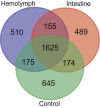The genome, transcriptome, and proteome of the nematode Steinernema carpocapsae: evolutionary signatures of a pathogenic lifestyle
- PMID: 27876851
- PMCID: PMC5120318
- DOI: 10.1038/srep37536
The genome, transcriptome, and proteome of the nematode Steinernema carpocapsae: evolutionary signatures of a pathogenic lifestyle
Abstract
The entomopathogenic nematode Steinernema carpocapsae has been widely used for the biological control of insect pests. It shares a symbiotic relationship with the bacterium Xenorhabdus nematophila, and is emerging as a genetic model to study symbiosis and pathogenesis. We obtained a high-quality draft of the nematode's genome comprising 84,613,633 bp in 347 scaffolds, with an N50 of 1.24 Mb. To improve annotation, we sequenced both short and long RNA and conducted shotgun proteomic analyses. S. carpocapsae shares orthologous genes with other parasitic nematodes that are absent in the free-living nematode C. elegans, it has ncRNA families that are enriched in parasites, and expresses proteins putatively associated with parasitism and pathogenesis, suggesting an active role for the nematode during the pathogenic process. Host and parasites might engage in a co-evolutionary arms-race dynamic with genes participating in their interaction showing signatures of positive selection. Our analyses indicate that the consequence of this arms race is better characterized by positive selection altering specific functions instead of just increasing the number of positively selected genes, adding a new perspective to these co-evolutionary theories. We identified a protein, ATAD-3, that suggests a relevant role for mitochondrial function in the evolution and mechanisms of nematode parasitism.
Figures




Similar articles
-
Signatures of co-evolutionary host-pathogen interactions in the genome of the entomopathogenic nematode Steinernema carpocapsae.BMC Evol Biol. 2017 Apr 26;17(1):108. doi: 10.1186/s12862-017-0935-x. BMC Evol Biol. 2017. PMID: 28446150 Free PMC article.
-
Pepsin-like aspartic protease (Sc-ASP155) cloning, molecular characterization and gene expression analysis in developmental stages of nematode Steinernema carpocapsae.Gene. 2012 Jun 1;500(2):164-71. doi: 10.1016/j.gene.2012.03.062. Epub 2012 Apr 4. Gene. 2012. PMID: 22503896
-
Specialization of the entomopathogenic nematode Steinernema scapterisci with its mutualistic Xenorhabdus symbiont.Naturwissenschaften. 2005 Oct;92(10):472-6. doi: 10.1007/s00114-005-0021-x. Epub 2005 Oct 28. Naturwissenschaften. 2005. PMID: 16163505
-
High Levels of the Xenorhabdus nematophila Transcription Factor Lrp Promote Mutualism with the Steinernema carpocapsae Nematode Host.Appl Environ Microbiol. 2017 May 31;83(12):e00276-17. doi: 10.1128/AEM.00276-17. Print 2017 Jun 15. Appl Environ Microbiol. 2017. PMID: 28389546 Free PMC article.
-
They've got a ticket to ride: Xenorhabdus nematophila-Steinernema carpocapsae symbiosis.Curr Opin Microbiol. 2007 Jun;10(3):225-30. doi: 10.1016/j.mib.2007.05.006. Epub 2007 Jun 5. Curr Opin Microbiol. 2007. PMID: 17553732 Review.
Cited by
-
The effect of temperature conditioning (9°C and 20°C) on the proteome of entomopathogenic nematode infective juveniles.PLoS One. 2022 Apr 7;17(4):e0266164. doi: 10.1371/journal.pone.0266164. eCollection 2022. PLoS One. 2022. PMID: 35390034 Free PMC article.
-
Hybrid Assembly of the Genome of the Entomopathogenic Nematode Steinernema carpocapsae Identifies the X-Chromosome.G3 (Bethesda). 2019 Aug 8;9(8):2687-2697. doi: 10.1534/g3.119.400180. G3 (Bethesda). 2019. PMID: 31113823 Free PMC article.
-
Transcriptome Profile Changes Associated With Heat Shock Reaction in the Entomopathogenic Nematode, Steinernema carpocapsae.Front Physiol. 2020 Jul 10;11:721. doi: 10.3389/fphys.2020.00721. eCollection 2020. Front Physiol. 2020. PMID: 32754045 Free PMC article.
-
Excreted secreted products from the parasitic nematode Steinernema carpocapsae manipulate the Drosophila melanogaster immune response.Sci Rep. 2022 Aug 20;12(1):14237. doi: 10.1038/s41598-022-18722-7. Sci Rep. 2022. PMID: 35987963 Free PMC article.
-
Immunomodulatory Effect of a Cysteine-Rich Secretory Protein from an Entomopathogenic Nematode with Sterol-Binding Activity.Toxins (Basel). 2025 Jul 5;17(7):342. doi: 10.3390/toxins17070342. Toxins (Basel). 2025. PMID: 40711153 Free PMC article.
References
-
- Oerke E.-C. Crop losses to pests. The Journal of Agricultural Science 144, 31–43, doi: 10.1017/S0021859605005708 (2006). - DOI
-
- Mukherjee P. K., Horwitz B. A., Herrera-Estrella A., Schmoll M. & Kenerley C. M. Trichoderma research in the genome era. Annual Review of Phytopathology 51, 105–129 (2013). - PubMed
Publication types
MeSH terms
Substances
LinkOut - more resources
Full Text Sources
Other Literature Sources
Molecular Biology Databases
Miscellaneous

